 W
WAlong the River During the Qingming Festival, also known by its Chinese name as the Qingming Shanghe Tu, is a painting by the Song dynasty painter Zhang Zeduan (1085–1145). It captures the daily life of people and the landscape of the capital, Bianjing during the Northern Song. The theme is often said to celebrate the festive spirit and worldly commotion at the Qingming Festival, rather than the holiday's ceremonial aspects, such as tomb sweeping and prayers. Successive scenes reveal the lifestyle of all levels of the society from rich to poor as well as different economic activities in rural areas and the city, and offer glimpses of period clothing and architecture. The painting is considered to be the most renowned work among all Chinese paintings, and it has been called "China's Mona Lisa."
 W
WThe Angelus is an oil painting by French painter Jean-François Millet, completed between 1857 and 1859.
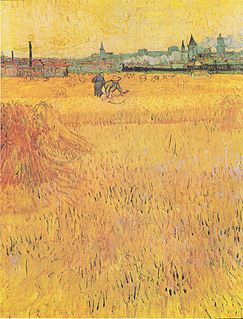 W
WArles: View from the Wheat Fields was painted by Vincent van Gogh in June, 1888, among a number of paintings he made of wheat fields that summer. It is currently displayed at the Musee Rodin in Paris, France.
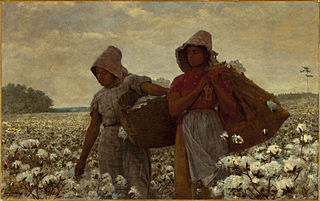 W
WThe Cotton Pickers is an 1876 oil painting by Winslow Homer. It depicts two young African-American women in a cotton field. Stately, silent and with barely a flicker of sadness on their faces, the two black women in the painting are unmistakable in their disillusionment: they picked cotton before the war and they are still picking cotton afterward.
 W
WCromwell on his Farm (1874) is a painting by Ford Madox Brown which depicts Oliver Cromwell observing a bonfire on his farm and thinking of a passage in the Book of Psalms: "Lord, how long wilt thou hide thyself - forever? And shall thy wrath burn like fire?". The words are inscribed on the painting's frame along with a quotation from one of Cromwell's speeches, in which he describes his life before entering into politics: "living neither in any considerable height, nor yet in obscurity, I did endeavour to discharge the duty of an honest man."
 W
WEnclosed Field with Peasant is an oil painting by Dutch artist Vincent van Gogh, painted around 12 October 1889. The Size 30 painting, measuring 73 cm × 92 cm, depicts a scene of a ploughed field near the asylum at Saint-Rémy-de-Provence, with a lilac bush, a peasant carrying a wheatsheaf, several buildings, and the Alpilles mountains rising behind, with a small patch of sky. Van Gogh considered it a pendant painting to The Reaper executed earlier in 1889. It is currently part of the permanent collection at the Indianapolis Museum of Art.
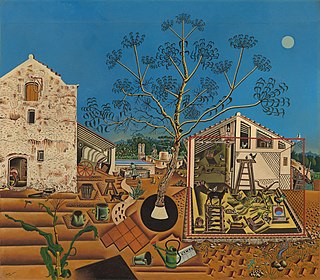 W
WThe Farm is an oil painting made by Joan Miró between the summer of 1921 in Mont-roig del Camp and winter 1922 in Paris. It is a kind of inventory of the masia owned by his family since 1911 in the town of Mont-roig del Camp. Miró himself regarded this work as a key in his career, describing it as "a summary of my entire life in the countryside" and "the summary of one period of my work, but also the point of departure for what was to follow." It is preserved in the National Gallery of Art in Washington DC, where it was given in 1987 by Mary Hemingway, coming from the private collection of American writer Ernest Hemingway, who had described it by saying, “It has in it all that you feel about Spain when you are there and all that you feel when you are away and cannot go there. No one else has been able to paint these two very opposing things.”
 W
WFarm with Stacks of Peat is an oil painting created by Vincent van Gogh in October or November 1883, early in his artistic career, and which is now in the collection of the Van Gogh Museum, Amsterdam. It was painted near the village of Nieuw-Amsterdam during the artist's short stay at Drenthe in the northern Netherlands.
 W
WFarmhouse in Provence, also known as Entrance Gate to a Farm with Haystacks, is an oil-on-canvas painting produced in 1888 by Dutch painter Vincent van Gogh in Arles, Provence, at the height of his career. Partially due to having been inspired by painter Adolphe Monticelli, Van Gogh sought the Provence region of France to further expand his painting skill and experience. Van Gogh used several pairs of complementary colors in the Farmhouse in Provence, the color contrast bringing an intensity to his work. The painting is owned by the National Gallery of Art in Washington, D.C.
 W
WFarmhouses in Loosduinen near The Hague at Twilight is an oil painting created in 1883 by Vincent van Gogh.
 W
WFarms near Auvers or Thatched Cottages by a Hill is an oil painting by Vincent van Gogh that he painted in July 1890 when he lived in Auvers-sur-Oise, France. The painting is an example of the double-square canvases that he employed in his last landscapes.
 W
WThe Gleaners is an oil painting by Jean-François Millet completed in 1857.
 W
WGrainfield at the Edge of a Wood, also known as The Cornfield, is a 1648 etching by the Dutch Golden Age artist Jacob van Ruisdael. There are five versions known about the etching. The first state is at the British Museum in London. The second state, in which a few lines in the sky have been added, is at the Rijksmuseum in Amsterdam. On the later states "JvRuysdael" has been added by another hand than Jacob's.
 W
WGreen Wheat Field with Cypress is an oil-on-canvas painting by Dutch Post-Impressionist Vincent van Gogh. It is held by the National Gallery Prague, displayed at the Veletržní palác in the district of Holešovice, where the painting is known as Zelené obilí.
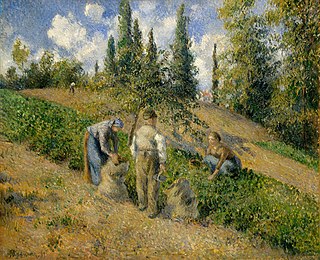 W
WThe Harvest, Pontoise is a late 19th-century painting by Dano-French artist Camille Pissarro. Done in oil on canvas, the work depicts a group of French farmers gathering potatoes; such subject material was a common theme used by Pissarro. The painting is in the collection of the Metropolitan Museum of Art.
 W
WLe Dépiquage des Moissons, also known as Harvest Threshing, and The Harvesters, is an immense oil painting created in 1912 by the French artist, theorist and writer Albert Gleizes (1881–1953). It was first revealed to the general public at the Salon de la Section d'Or, Galerie La Boétie in Paris, October 1912. This work, along with La Ville de Paris by Robert Delaunay, is the largest and most ambitious Cubist painting undertaken during the pre-War Cubist period. Formerly in the collection of the Solomon R. Guggenheim Museum in New York, this monumental painting by Gleizes is exhibited at the National Museum of Western Art, in Tokyo, Japan.
 W
WHarvest Time at Carditello is a 1791 oil on canvas painting by Jakob Philipp Hackert, who had become a painter to the royal court at Naples. In 1791 he was commissioned to paint frescoes in the 'salottino' of the manorhouse at Carditello, but the cycle was partly destroyed by anti-Bourbon figures following the unification of Italy.
 W
WThe Harvesters is an oil painting on wood completed by Pieter Bruegel the Elder in 1565. It depicts the harvest time, in the months of July and August or late summer. Nicolaes Jonghelinck, a merchant banker and art collector from Antwerp, commissioned this painting.
 W
WHarvesters is a 1905 oil painting on canvas by the Danish artist Anna Ancher, a member of the artists' community known as the Skagen Painters which flourished in Skagen in the north of Jutland in Denmark in the late 19th and early 20th centuries.
 W
WThe Hay Harvest, is an oil on wood painting created by Pieter Bruegel, in 1565. The most important of the Lobkowiczes' Northern pictures, it was hung in the dining room of the Antwerp merchant Niclaes Jongelink. This picture was originally part of a series of six panels, each presumed to represent two months of the year – in this case June and July.
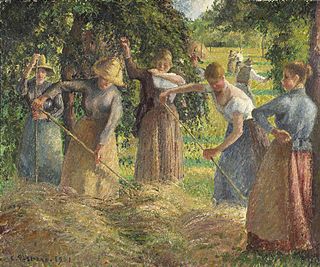 W
WHay Harvest at Éragny is a 1901 painting by French Impressionist painter Camille Pissarro depicting the hay harvest in the French commune of Éragny-sur-Epte.
 W
WHaymaking or Resting in the Fields is an 1877 painting by Jules Bastien-Lepage. First exhibited at the 1878 Paris Salon, it was acquired by the Musée du Luxembourg in 1885 at the posthumous sale of the artist's works. It passed to the Louvre in 1929 and then to its current home in the Musée d'Orsay in 1980.
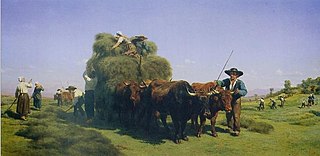 W
WHaymaking in the Auvergne is an 1855 oil painting by French artist Rosa Bonheur. It measures 215 cm × 422 cm.
 W
WHaystacks is the common English title for a series of impressionist paintings by Claude Monet. The principal subject of each painting in the series is stacks of harvested wheat. The title refers primarily to a twenty-five canvas series which Monet began near the end of the summer of 1890 and continued through the following spring, though Monet also produced five earlier paintings using this same stack subject.
 W
WHaystacks: Autumn is a c. 1874 painting by French artist Jean-François Millet. Done in oil on canvas, the work depicts a group of haystacks in a French field. The painting is one of a series of four paintings, one for each season, that Millet pained on commission for a French industrialist. The work is in the collection of the Metropolitan Museum of Art.
 W
WThe Haywain Triptych is a panel painting by Hieronymus Bosch, now in the Museo del Prado, Madrid, Spain. A date of around 1516 has been established by means of dendrochronological research. The central panel, signed "Jheronimus Bosch", measures 135 cm × 200 cm and the wings measure 147 cm × 66 cm. The outside shutters feature a version of Bosch's The Wayfarer.
 W
WLandscape near Arles is an 1888 oil painting by French artist Paul Gauguin, located in the Indianapolis Museum of Art, which is in Indianapolis, Indiana. It depicts a rural scene in Provence.
 W
WLandscape with a Carriage and a Train is an oil painting by Vincent van Gogh that he painted in June 1890 when he lived in Auvers-sur-Oise, France.
 W
WOctober is an 1878 painting by Jules Bastien-Lepage, now in the National Gallery of Victoria in Melbourne. It is also known as Picking Potatoes, The Potato Gatherers or Woman Gathering Potatoes.
 W
WPeasant with a Wheelbarrow is an oil painting by French artist Jean-François Millet, located in the Indianapolis Museum of Art, which is in Indianapolis, Indiana. Begun in 1848 but not finished until Millet found a buyer in 1852, it depicts a peasant man pushing a wheelbarrow.
 W
WThe Peasants' Return From The Fields is a c. 1640 painting by Peter Paul Rubens. It arrived in Florence in 1765 and is now in the Galleria Palatina in Florence.
 W
WThe Potato Harvest is an 1855 painting by the French artist Jean-François Millet.
 W
WPublic Sale is a 1943 painting by the American artist Andrew Wyeth. It shows two men by a car and in the distance a crowd of people outside a farm building. The event depicted is the forced auction of a farm after the farmer's wife had died.
 W
WReapers Resting in a Wheat Field is a late 19th-century painting by American impressionist John Singer Sargent. Done in oil on canvas, the painting a scene set in a wheat field near the village of Broadway, Worcestershire.
 W
WThe Red Vineyards near Arles is an oil painting by the Dutch painter Vincent van Gogh, executed on a privately primed Toile de 30 piece of burlap in early November 1888. It depicts workers in a vineyard, and is believed to be the only painting known by name that van Gogh sold during his lifetime.
 W
WThe Sower, created in 1907, is an oil on canvas painting by the Slovene Impressionist painter and musician Ivan Grohar. It is an image of a peasant sowing seeds on a ploughed field in an early and foggy morning. A hayrack, typical of the Slovene landscape, stands in the back, and even farther, the rocks of the small hill Kamnitnik near Škofja Loka. It has been a metaphor for the 19th-century myth of Slovenes as a vigorous nation in front of an unclear destiny, a symbol for the Slovene nation that sows in order that it could harvest, and a depiction of human interrelatedness with the nature. It is also a reflection of the context of Slovene transition from a rural to an urban culture. It has become one of the most characteristic and established Slovene creations in visual arts. It has been used by the IRWIN art group as well as the Semenarna Ljubljana seed company, and is depicted on the Slovenian 5 cent euro coin.
 W
WThe Cranberry Harvest, Island of Nantucket is an 1880 oil painting on canvas by Eastman Johnson.
 W
WThe Tilled Field is a 1923–1924 oil-on-canvas painting by Catalan painter Joan Miró, depicting a stylised view of his family's farm at Mont-roig del Camp in Catalonia. The painting shows development from Miró's earlier works, such as The Farm, and is considered to be one of his first Surrealist works, created around the same time as the more abstracted Catalan Landscape . It is held by the Solomon R. Guggenheim Museum in New York.
 W
WTornado over Kansas, or simply The Tornado, is a 1929 oil on canvas painting by American Regionalist painter John Steuart Curry. It depicts a dramatic scene in which a family races for shelter as a tornado approaches their farm, and has compositional connections to Curry's earlier 1928 painting Baptism in Kansas. The artist was influenced by Baroque art and photographs of tornadoes. He developed a fear of natural disasters and a reverence towards God during his childhood, both of which are seemingly apparent in the painting.
 W
WThe Wheat Field is a series of oil paintings executed by Vincent van Gogh in Saint-Rémy-de-Provence. All of them depict the view Van Gogh had from the window of his bedroom on the top floor of the asylum: a field enclosed by stone walls just beneath his window and excluded from normal life by the rear wall of the asylum grounds; beyond this enclosure farm land, accompanied by olive groves and vineyards, ran up to the hills at the foot of the mountain range called Les Alpilles.
 W
WIn 1887, while Vincent van Gogh was residing in Paris, he executed an oil painting commonly known as Wheat Field with a Lark.
 W
WWheat Fields is a series of dozens of paintings by Dutch Post-Impressionist artist Vincent van Gogh, borne out of his religious studies and sermons, connection to nature, appreciation of manual laborers and desire to provide a means of offering comfort to others. The wheat field works demonstrate his progression as an artist from the drab Wheat Sheaves made in 1885 in the Netherlands to the colorful, dramatic paintings from Arles, Saint-Rémy and Auvers-sur-Oise of rural France.
 W
WWheat Fields is a late 17th century oil painting by Jacob van Ruisdael. The painting depicts a wheat field in the Netherlands.
 W
WWheatfield with Crows is a July 1890 painting by Vincent van Gogh. It has been cited by several critics as one of his greatest works.
 W
WA Wheatfield with Cypresses is any of three similar 1889 oil paintings by Vincent van Gogh, as part of his wheat field series. All were exhibited at the Saint-Paul-de-Mausole mental asylum at Saint-Rémy near Arles, France, where Van Gogh was voluntarily a patient from May 1889 to May 1890. The works were inspired by the view from the window at the asylum towards the Alpilles mountains.
 W
WWinter Fields is a 1942 painting by the American artist Andrew Wyeth. It depicts a dead, frozen crow in a landscape with fields and distant farm buildings.